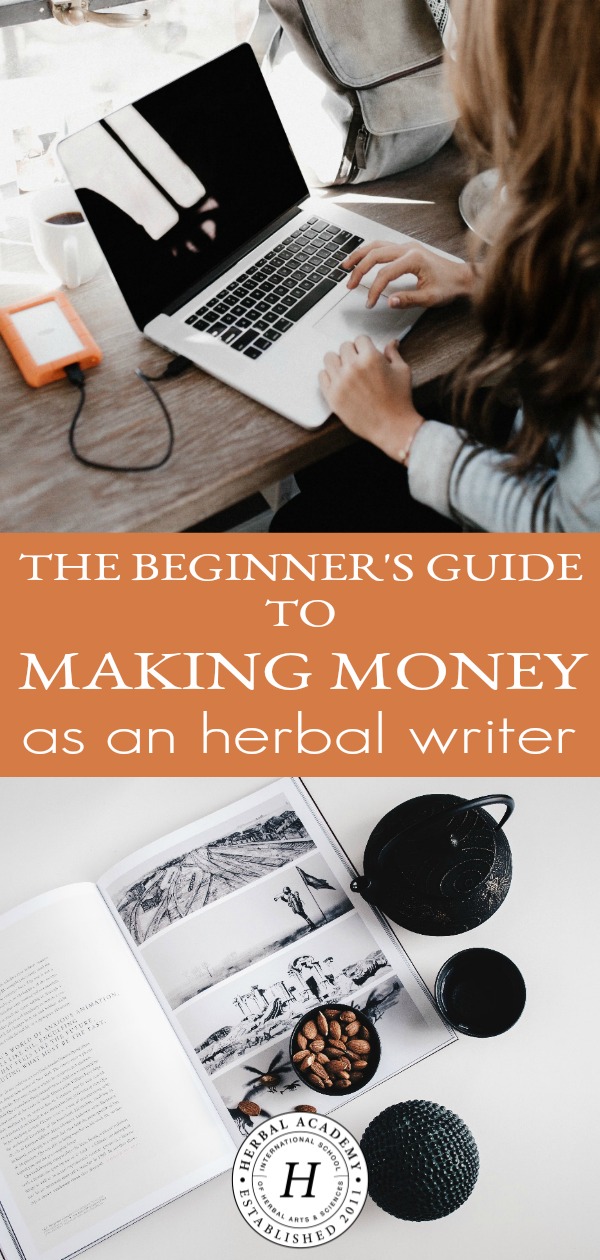
The Beginner’s Guide to Making Money as an Herbal Writer
If you enjoy writing, and you’re looking for creative ways to make money from your herbal know-how, then submitting articles to magazines and reputable online platforms may be a great option for you.
For seven years, I worked as the health editor for a well-known sustainable lifestyle magazine. I received dozens of pitches per week from freelance writers hoping to be featured in the pages of our publication. Over time, I came to recognize a well-written and compelling pitch at a glance.
I’ve summarized how to write a great pitch (also called a “query”) below, and by following these tips, you’ll be that much closer to becoming an herbal writer and landing your dream assignment.
How To Make Money As An Herbal Writer
Write What You Know
Most reputable publications will prefer working with an M.D., naturopath, or certified health professional for articles about serious health conditions, such as “Best Herbs for Cardiovascular Health.” If you don’t have these credentials, then you could always offer to interview someone who does. If you go that route, then make sure to research your proposed interviewee beforehand, confirm that they’re available, and include their name in the pitch so the editor can research their credentials.
Another option for the budding herbal writer is to stick with articles that lean more toward the DIY, gardening, healthy cooking, and skin care realm. For example, “How to Make a Salve,” “Cooking with Sage,” and “Grow Peppermint in Containers” are all articles for which hands-on experience outshines the need for credentials.
Keep in mind that many publications plan their content calendar about six months in advance. This means that while you’re thinking about herbal chai recipes for the holidays, the editors are thinking about after-sun sprays for summer. While you can certainly submit article ideas any time of year, there’s a better chance that you’ll receive an assignment right out of the gate if you’re seasonally aligned with the issues that the editors are planning.
After you’ve settled on a topic, do a bit of research to make sure it’s a good fit for the publication you want to write for. Read the publication – either online or in print – to get a feel for their voice and average article length.

I also highly recommend doing a bit of research to make sure the publication hasn’t already covered your topic in the last few years. I can’t tell you how many well-written and interesting queries I received but had to say “no” to because we’d already covered that topic recently. While doing your research, if you find that the publication has featured your topic within the last two to three years, then try to think about a fresh angle or spin that you could give it.
When getting started as an herbal writer, stick to topics that you truly have first-hand experience with. Not only are these articles more compelling and authentic to read, but you’ll have more fun writing them because you won’t have to research and double-check every sentence.
Research Submission Guidelines
Each publication has different submission guidelines – some prefer a written email, some prefer Word documents attached to an email, some simply have a “contact” form on their website. Before you start writing your pitch, take some time to make sure it’s in the proper format and that it includes all of the publication’s requested information.
Make Your Pitch Personal and Professional
After you’ve settled on an interesting topic and you know the necessary format, it’s time to contact your favorite publication(s) to see if they’ll engage you. This email will serve as a cover letter for landing an exciting freelance contract as an herbal writer, so it’s important that there aren’t any spelling or grammatical errors. Whenever I received a query that was poorly written or full of errors, I immediately dismissed the author as someone who was not ready to write for a nationally available publication – regardless of how interesting their article idea was.
Many freelance writers will put together a form letter and then send it off to dozens of editors in hopes that at least one of them will respond. The problem with this tactic is that it comes across as spam to the editor, who can immediately tell that there’s nothing personal about the note. I typically deleted these emails without even responding (sorry!).
Instead, take some time to research the name of the editor you’re trying to contact. As I mentioned earlier, read the magazine or publication that you hope to be featured in and then weave that personal knowledge into your pitch. Here’s an example of how you could start your pitch in a warm and personal way:
Dear Rebecca, (use the editor’s name whenever possible)
I’ve read your publication for years, and I’m always excited to find it in my mailbox. I particularly enjoyed the article about DIY tea blends from the June/July 2018 issue, and it’s inspired me to send you an idea for an article that I would love to contribute.
Short and Sweet

After you’ve grabbed the editor’s attention by writing something personal and direct, keep in mind that they are extremely busy people and often receive multiple pitches per day. Your pitch needs to be short and sweet.
Rather than explaining every detail of your proposed article, it’s best to summarize the topic in a few sentences while remembering that the editor will follow up for more information if they’re interested.
For example:
DIY Salves: Salves are simple yet effective home preparations made by combining herb-infused oils with beeswax. In my proposed article, I will define salves, provide a short history of their use, and outline step-by-step instructions for how to make two of my family’s favorite salves: one for bumps and bruises and one for sore muscles. Because many of your readers are also gardeners, I would include instructions for how to use plants from your own garden while making salves, along with tips for sourcing local, sustainably harvested beeswax.
Explain Your Credentials
Next, you’ll want to include a few short sentences about why you’re the best writer for the topic. If you’re a certified health care practitioner, then certainly include your credentials. If you’re a budding or family herbalist, then you could include something along these lines:
I have made salves for my family for more than 10 years, and I often use homegrown herbs. I recently completed the Herbal Academy’s online Entrepreneur Path, during which I extensively studied safe herbal practices, contraindications, and DIY preparations. I also apprenticed with a local herbalist for six months in 2015.
Include Writing Samples
Your pitch itself will serve as a writing sample, which is why you’ll want to make sure it’s very well-written. However, beyond having a polished pitch, you should also include attachments or hyperlinks to a few additional writing samples, if possible. If you already have published work, then that’s fantastic – include that! If you don’t, then I would seriously consider starting a blog. Maintaining a blog will give you an opportunity to fine-tune your writing skills, and it will serve as your portfolio when editors go to research your writing capabilities. (There are a few simple website-building platforms, like Wix and Squarespace that makes it easy to build a blog regardless of your experience.)
If you don’t have any published work, then don’t let that hold you back! All freelance writers start somewhere, and after you get your foot in the door with the right publication then you’ll be able to start growing your portfolio.
Photography Add-Ons

Most publications work with stock photography websites and a handful of dedicated photographers to get the images they need. However, if you take beautiful photographs and are able to provide high-quality images to accompany your text, then many editors will see this as a gold star. When submitting your pitch, let the editor know that you can provide images to accompany your text. Include a link to your photography website (or even your Instagram page) so the editor can review your photography skills.
Depending on the publication, providing your own images will usually increase the amount you’re paid. You’ll either receive a higher amount for the package (both text and photos) or the editor will offer you a set amount for each image they’re able to use in print.
Following Up
It may take the editor a while to respond, so don’t feel discouraged if you don’t hear back immediately. If a few weeks go by and you still haven’t heard anything, then I would encourage you to follow up once – but retain a helpful and curious tone and try not to be pushy!
If they do get back to you with a “no,” then try not to take it personally. There were times when a freelance writer would submit six or seven queries before I ultimately felt like one resonated with what I was looking for. Sometimes their ideas never quite clicked, and I would gently tell them that this publication wasn’t a good fit for their style or topic area.
Landing the Job

If you receive a “yes,” then congratulations! Before you get started, here are few common newbie mistakes an herbal writer may make that I’d like to help you avoid. First of all, check your email regularly for follow-up questions or requests from the editor. From the editor’s perspective, there’s nothing more frustrating than working on a tight deadline and not being able to contact the person you’ve hired.
Speaking of deadlines, respect them. If your article is due January 15th for example, then definitely plan on submitting your article by then – if not earlier. If you’re going to be late for some unforeseen reason, then contact your editor, explain the situation, and let them know a date for when they can expect your article.
Any reputable publication will ask you to footnote any and all health claims, so make sure you’re using quality resources. A good way to sort through all the misinformation on the web is to enter your search term into Google Scholar, which will pull up scientific studies related to your topic (rather than blog posts, Wikipedia pages, etc.).
For the right person, writing about your herbal journey will be a fun, creative, and rewarding way to make a bit of side money from your hobby. Best of luck, and happy writing!









